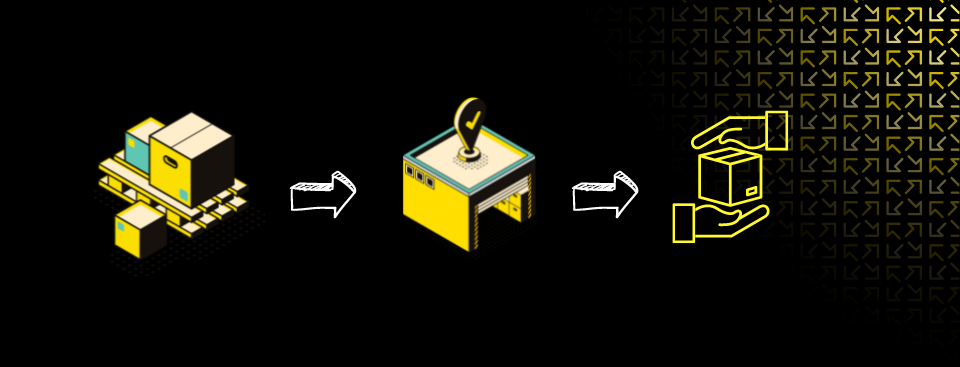Inbound and Outbound Logistics — What They Are and Important KPIs to Track

Inbound and outbound logistics — What They Are and Important KPIs to Track
Whether you are selling chocolate bars or robot vacuums that clean your floors while you nap, any business selling products needs to deal with two things: inbound and outbound logistics.
So, what exactly are inbound and outbound logistics?
Inbound and outbound logistics are two parts that make up the whole of your supply chain. Inbound logistics refers to the first half— the processes that bring the materials or products to your business.
Once you have the finished product at your warehouse, outbound logistics takes over. The outbound logistics stage refers to all the actions related to and necessary for delivering products to customers.
For inbound, the goal is to secure the supply for your company. For outbound, the goal is to fill demand.
Whether you are managing your inbound/outbound logistics with an in-house team or outsourcing services to a 3PL or 4PL, it's imperative to a successful supply chain strategy that they work well in harmony.
How can you achieve that? By using data analytics and KPIs, or key performance indicators, to diagnose problems and help you understand what is going on in your supply chain.
Read through our list of inbound and outbound processes, then check out some of the KPIs e-commerce retailers rely on to evaluate and optimize their inbound and outbound logistics.
Read about CBIP's Adaptable 4PL Logistics Services
What is inbound versus outbound logistics and who is involved?
As noted above, the components of your supply chain can all be grouped into two main categories; Inbound and outbound logistics.
Looking at the below list, consider which parts you best understand when it comes to your company. How well do you know what’s going on with the “players” in your inbound and outbound logistics?
What processes are part of inbound logistics?
The term “Inbound logistics” encompasses everything that happens between sourcing the raw materials for your product and the moment when the finished product enters the warehouse to await orders.
Inbound processes include:
- Finding materials
- Managing transportation from source to factory and factory to warehouse
- Warehousing
The parties involved in inbound logistics are responsible for transporting, storing, and receiving your materials and goods. Starting from the supplier, your product moves down the chain to manufacturers, then freight companies, and finally ends up at your warehouse.
What processes make up outbound logistics?
Inbound logistics includes all processes that happen after the customer’s order comes in. This includes order fulfillment and last mile, returns, and general customer service after the parcel is delivered.
Outbound processes include
- Confirming and processing inventory at the warehouse
- Picking and packaging orders as they come in
- Last-Mile Delivery
- Returns and post-delivery customer service
The outbound part of logistics is when orders are packaged up and delivered to the customer.
Related: How to Manage B2B Fulfillment Today
How to optimize both outbound and inbound using KPIs
Getting a handle on all outbound and inbound processes can seem like a daunting task — it can be challenging to figure out a problem in one area of a supply chain, let alone all of them consistently.
We'd suggest using a checklist of the most telling KPIs, or key performance indicators, to point out areas where you are killing it, and areas that need some work or outsourced help. KPIs use data analytics to tell you how specific areas of your business are performing.
The biggest indicators that retailers are tracking in the inbound processes are:
- Freight bill accuracy
- Loading and unloading times
- Lead times
- Production times
For inbound logistics, time and accuracy rule the roost. Nearly 34% of companies have had to ship out a late order because they didn’t actually have a product in stock. That kind of lack of insight into what inventory your warehouse has on hand can cause major customer frustrations.
Think of the children’s game “telephone”— if accurate documentation and information are not making it down the line to each supply chain step, you will end up with a faulty message.
When we’re talking about outbound KPIs, the most important considerations are how accurately orders are filled and how long the last mile of fulfillment winds up taking. After the orders come in, you should be looking at indicators like:
- Order fill rate
- Order accuracy rate
- Average delivery time
- Customer order cycle time
- Time to ship
Optimize outbound and inbound by teaming up with CBIP
While new technologies in data analytics are making it easier than ever to use data from your business to make key decisions, pulling, compiling, and analyzing all the data from your inbound and outbound logistics processes can be a huge burden for companies.
When you decide to partner with us at CBIP, you get access to all the info and data from your supply chain available on our integrated platform any time you want it — not to mention an immense network of warehouses, fulfillment centers, and last-mile providers.
Interested in getting access to the data and visibility to understand better what is happening in your inbound and outbound logistics and fix bottlenecks? Reach out today to connect with one of our professionals for a free assessment.






